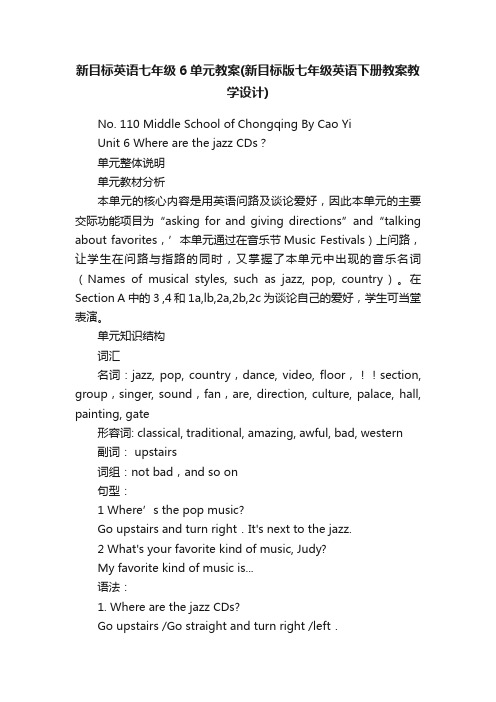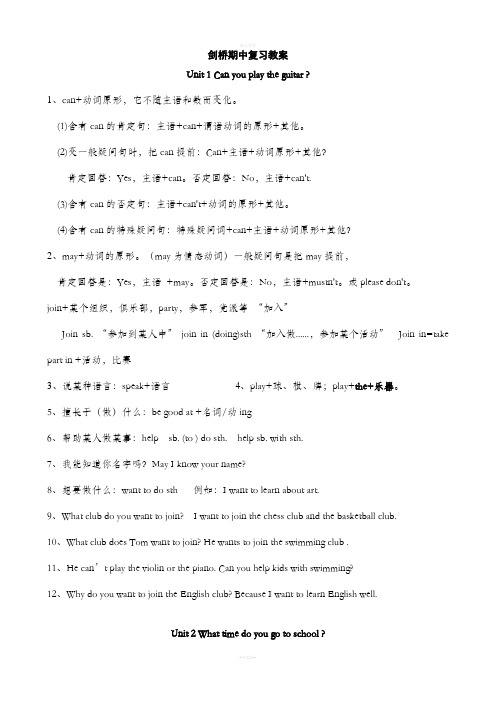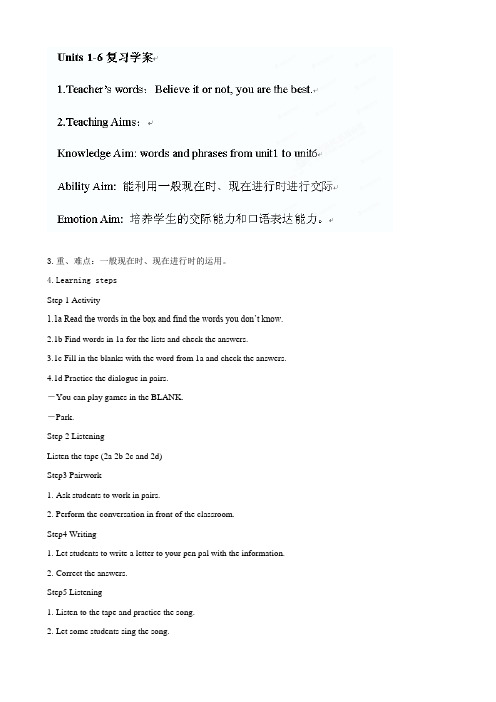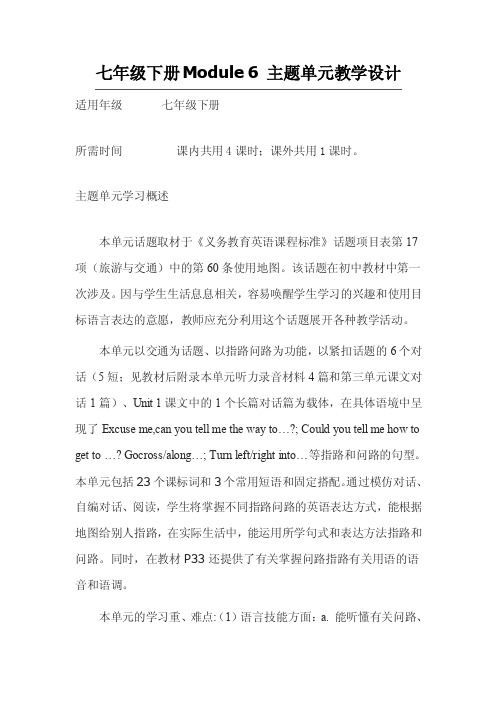七年级下册英语-6单元复习教案
新目标英语七年级6单元教案(新目标版七年级英语下册教案教学设计)

新目标英语七年级6单元教案(新目标版七年级英语下册教案教学设计)No. 110 Middle School of Chongqing By Cao YiUnit 6 Where are the jazz CDs?单元整体说明单元教材分析本单元的核心内容是用英语问路及谈论爱好,因此本单元的主要交际功能项目为“asking for and giving directions”and“talking about favorites,’本单元通过在音乐节Music Festivals)上问路,让学生在问路与指路的同时,又掌握了本单元中出现的音乐名词(Names of musical styles, such as jazz, pop, country)。
在Section A中的3 ,4和1a,lb,2a,2b,2c为谈论自己的爱好,学生可当堂表演。
单元知识结构词汇名词:jazz, pop, country,dance, video, floor,!!section, group,singer, sound,fan,are, direction, culture, palace, hall, painting, gate形容词: classical, traditional, amazing, awful, bad, western副词: upstairs词组:not bad,and so on句型:1 Where’s the pop music?Go upstairs and turn right.It's next to the jazz.2 What's your favorite kind of music, Judy?My favorite kind of music is...语法:1. Where are the jazz CDs?Go upstairs /Go straight and turn right /left.They are between the pop and the country2 The use of the sentences structures.单元整体目标1.Master the vocabulary.2.Master and use:Where are the country CDs?Go upstairs /Go straight and turn right /left.They are between …and …/next to… behind …单元教学重难点一览重点难点I The vocabulary.2 The Grammar. 1 Asking for and giving directions.2 Talking about favorite.单元学情分析本单元与前几个单元的学习自然衔接,继续学习询问和指点方向,而且与学生愿意接触的“音乐“有关,很大程度上能调动学生的学习积极性。
七年级下册英语1-6单元复习教案

剑桥期中复习教案Unit 1 Can you play the guitar ?1、can+动词原形,它不随主语和数而变化。
(1)含有can的肯定句:主语+can+谓语动词的原形+其他。
(2)变一般疑问句时,把can提前:Can+主语+动词原形+其他?肯定回答:Yes,主语+can。
否定回答:No,主语+can't.(3)含有can的否定句:主语+can't+动词的原形+其他。
(4)含有can的特殊疑问句:特殊疑问词+can+主语+动词原形+其他?2、may+动词的原形。
(may为情态动词)一般疑问句是把may提前,肯定回答是:Yes,主语+may。
否定回答是:No,主语+mustn't。
或please don't。
join+某个组织,俱乐部,party,参军,党派等“加入”Join sb. “参加到某人中” join in (doing)sth “加入做......,参加某个活动” Join in=take part in +活动,比赛3、说某种语言:speak+语言4、play+球、棋、牌;play+the+乐器。
5、擅长于(做)什么:be good at +名词/动ing6、帮助某人做某事:help sb. (to ) do sth. help sb. with sth.7、我能知道你名字吗?May I know your name?8、想要做什么:want to do sth 例如:I want to learn about art.9、What club do you want to join? I want to join the chess club and the basketball club.10、What club does Tom want to join? He wants to join the swimming club .11、He can’t play the violin or the piano. Can you help kids with swimming?12、Why do you want to join the English club? Because I want to learn English well.Unit 2 What time do you go to school ?1、what time和when引导的特殊疑问句。
Module 6【复习课件】七年级英语下册单元复习(外研版)

相当于across from, 常与名词短语连用表方位.
The store is opposite/ across from the station.
across cross vt
prep (在表面)越过, 横穿 穿过, 横穿 v + across + sth = cross sth
重点语法
3. turn vt. 转弯 turn left / right
左转、右转
Turn left into Chang'an Jie and turn right into Chang Jie. turn left / right into …左/ 右转到/进入…
表示方位的介词
1.Our house is__o_n__th_e__r_ig_h_t_o_f___(在……右边) the park. 2.There is a museum_o_p_p_o_s_i_te_/_a_c_r_o_s_s_f_r_o_m_ (在……对面) the square. 3.There is a big library___n__e_x_t _to___ (紧挨着) our school. 4.The teacher is standingi_n_t_h_e_m__i_d_d_le__o(f在…中间) the classroom. 5.The shop is_o_n__th_e__o_th__e_r _s_id_e__o(f在……另一边) the street.
( D )1.2018·包头—Are you watching the football
matches of the World Cup these days?
—Sometimes, and I'll watch the match ________
精选】人教版七年级下册英语Unit6第六单元优秀教案

精选】人教版七年级下册英语Unit6第六单元优秀教案Unit 6: I'm Watching TVLesson 1: n A (1a-1c)XXX:1.Key Vocabulary: newspaper。
use。
soup。
wash2.Key Phrases: read a newspaper。
using the computer。
making soup3.Key Sentence Structures:What's he doing?He's using the computer.What are they doing?XXX.Focus of Learning:Present Continuous XXXChallenges:1.n of Present Participle (-ing)2.XXX using Present Continuous XXXIndependent Study:1.Preview the new words on page 31 and memorize them。
Translate the following words from Chinese to English: 报纸 (newspaper)使用 (use)汤 (soup)洗 (wash)2.Preview ns 1a。
1b。
and 1c。
Identify the following phrases and sentence structures:read a newspaperusing the computermaking souptalking on the computerWhat's he doing。
He's using the computer.What are they doing。
They are XXX.Classroom Guidance:Step 1: nXXX some students to perform ns in front of the class。
安徽省毫州市谯城区三官初级中学英语七年级下册 Units 1-6 单元复习学(人教版新目标)(英语教案)

3.重、难点:一般现在时、现在进行时的运用。
4.Learning stepsStep 1 Activity1.1a Read the words in the box and find the words you don’t know.2.1b Find words in 1a for the lists and check the answers.3.1c Fill in the blanks with the word from 1a and check the answers.4.1d Practice the dialogue in pairs.-You can play games in the BLANK.-Park.Step 2 ListeningListen the tape (2a 2b 2c and 2d)Step3 Pairwork1. Ask students to work in pairs.2. Perform the conversation in front of the classroom.Step4 Writing1. Let students to write a letter to your pen pal with the information.2. Correct the answers.Step5 Listening1. Listen to the tape and practice the song.2. Let some students sing the song.Step6 Self check1. Work in pairs and complete the questions.2. Point out something important.(1)I found unit 1 to be the most interesting.(2)I hope to do the following three things in order to improve my English. Step6、达标检测一、单项选择1. I like eggs, meat ________bread.He doesn't like rice , bananas _________bread .A. and; andB. and; orC. or; orD. or; and2. The students play games ______ Thursday afternoon .A. onB. atC. inD. of3. My father________ in a shop, but he _______ there these days.A. works; isn't workingB. is working; worksC. works; not worksD. is work; doesn't work4. The Australian people _______A. are friendsB. is friendlyC. very friendlyD. are friendly5. -- ______is the bank? --It' s on Center Street.A. WhatB. WhereC. HowD. When6. --Is there a bus station near here? --It's across _______ the bank.A. toB. atC. fromD. on7. Is your home_____ the neighborhood?A. inB. onC. toD. near8.Look! Mary _______with her two good friends.A. talkingB.talkC. talksD. is talking9.– How about ________ soccer? – Good idea!A. playingB. playC. to playD. plays10.Could you tell me ________ ?A. the way to the stationB. way to stationC. where the stationD.there is the station二、用所给词的适当形式填空( 包括同音词,反义词) 。
人教PEP七年级下册英语unit6Section A (1a~2d)教案与教学反思

第6单元I’m watching TV. 上信中学陈道锋类别课程标准要求掌握的内容话题Everyday activities日常活动Section A 单词newspaper n.报纸 use v.使用;运用 soup n.汤wash v.洗 movie n.电影 just adv.只是;恰好house n.房子 drink v.喝 n.饮料 tea n.茶;茶叶tomorrow adv.在明天 n.明天;未来短语read a newspaper 看报纸 talk on the phone通过电话交谈use the computer 使用电脑 make soup 做汤wash the dishes 洗餐具 go to the movies 看电影eat out出去吃饭 make dinner 做晚饭 drink tea 喝茶句型1.—What’s she doing? 她在做什么?—She’s washing her clothes.她在洗她的衣服。
2.—Are you doing your homework? 你在做你的家庭作业吗?—Yes, I am. /No, I’m not. I’m cleaning my room.是的,我在做。
/不,我没做。
我在打扫我的房间。
3.—Is he reading a newspaper?他在看报纸吗?—Yes, he is./No, he isn’t. He’s playing basketball.是的,他在看。
/不,他没有看。
他正在打篮球。
Section B单词pool n.游泳池;水池 shop v.购物 n.商店supermarket n.超市man n.男人;人 race n.竞赛study v. & n.学习;研究state n.州 the United States 美国;美利坚合众国any adj.任何的;任一的pron.任何;任一 child n.儿童(pl.children)other adj.另外的;其他的pron.另外的人(或物) wish v.希望oung adj.幼小的;年轻的 miss v.怀念;思念;错过delicious adj.可口的;美味的 still adv. 还;仍然American adj.美国的;美洲的 n.美国人;美洲人host n.主人;东道主 dragon n.龙短语live with sb.和某人一起住 Dragon Boat Festival 端午节make zongzi 包粽子 watch… on TV 在电视上看……the night befoe 前一天夜里 host family寄宿家庭read a story to sb.读故事给某人听 living room 客厅talk show脱口秀 study for为……考试而学习句型1.…, so it’s like any other night for Zhu Hui and his host family.……,所以对朱辉和他的寄家庭来说,今晚和任何一个平常的晚上是一样的。
人教版初一下英语七年级第六单元教案

人教版初一下英语七年级第六单元教案人教版出一下英语七年级第6单元教案【教师寄语:Where there is life ,there is hope. 有生命必有希望!】Unit 6 I am watching TV【基础知识】一、语法讲解--现在进行时(一)、定义现在进行时表示现在(说话的瞬间)正在进行或发生的动作。
(二)、用法:A表示现在( 指说话时) 正在发生的事情。
例:We are waiting for you.B. 表示现阶段正在进行的动作,说话时未必正在进行。
例:Mr. Green is writing another novel.C.已经确定或安排好的但不确定会不会发生的将来活动。
I'm leaving for a travel in Nepal next week.(我下周要去尼泊尔旅行) We're flying to Paris tomorrow(我们明天乘飞机去巴黎)(三)、构成现在进行时的构成是:主语+be+v.ing〔现在分词〕形式第一人称单数I+am+V-ing. 第一人称复数We+are+V-ing. 第二人称单(复)数You+are+V-ing. 第三人称单数He(She,It)+is+V-ing. 第三人称复数They+are+V-ing.(四)、句型变化(1)肯定式:be+v-ing She is singing in the next room. (2)否定式:be+not+v-ing The students aren’t cleaning the room. (3)一般问句:be动词提前。
肯定答语Yes,主语+be; 否定答语No,主语+be not。
Are you playing the computer game? Yes, I am. No, I am not. (4)特殊问句:对谓语动词进行提问的:What+be +主语+doing+其他?What is the old man doing under the tree? 对其他成份进行提问的,疑问词+一般疑问句?人教版出一下英语七年级第6单元教案Where is the boy swimming? Who is she waiting for?【及时训练】1、按要求改写句子The boy is playing basketball.否定句:____________________________ 一般疑问句:_________________________肯定回答:__________________________否定回答:__________________________ 对“The boy”提问:__________________________2、把对话补充完整。
初中英语七年级下册Module6主题单元教学设计以及思维导图

七年级下册Module 6 主题单元教学设计适用年级七年级下册所需时间课内共用4课时;课外共用1课时。
主题单元学习概述本单元话题取材于《义务教育英语课程标准》话题项目表第17项(旅游与交通)中的第60条使用地图。
该话题在初中教材中第一次涉及。
因与学生生活息息相关,容易唤醒学生学习的兴趣和使用目标语言表达的意愿,教师应充分利用这个话题展开各种教学活动。
本单元以交通为话题、以指路问路为功能,以紧扣话题的6个对话(5短;见教材后附录本单元听力录音材料4篇和第三单元课文对话1篇)、Unit 1课文中的1个长篇对话篇为载体,在具体语境中呈现了Excuse me,can you tell me the way to…?; Could you tell me how to get to …? Gocross/along…; Turn left/right into…等指路和问路的句型。
本单元包括23个课标词和3个常用短语和固定搭配。
通过模仿对话、自编对话、阅读,学生将掌握不同指路问路的英语表达方式,能根据地图给别人指路,在实际生活中,能运用所学句式和表达方法指路和问路。
同时,在教材P33还提供了有关掌握问路指路有关用语的语音和语调。
本单元的学习重、难点:(1)语言技能方面:a. 能听懂有关问路、指路的简短对话;b.能用英语指路和问路;c.能够读懂对地图或一个地方的描述;d.能清楚地用书面文字给别人指路;e.能根据地图讲清路线,描述出某个地点的位置。
(2)语言知识方面:23个课标词和3个常用短语和固定搭配;Grammar Focus中的句型以及询问指路问路的相关句子。
Can you tell me the way to…? Couldyou t ell me how to get to…?(3)学习策略:能够将语言学习和实际应用结合起来,学会看地图、使用地图,并能够运用找读(Scanning)等阅读学习策略,快速获取有效信息。
- 1、下载文档前请自行甄别文档内容的完整性,平台不提供额外的编辑、内容补充、找答案等附加服务。
- 2、"仅部分预览"的文档,不可在线预览部分如存在完整性等问题,可反馈申请退款(可完整预览的文档不适用该条件!)。
- 3、如文档侵犯您的权益,请联系客服反馈,我们会尽快为您处理(人工客服工作时间:9:00-18:30)。
剑桥期中复习教案Unit 1 Can you play the guitar ?1、can+动词原形,它不随主语和数而变化。
(1)含有can的肯定句:主语+can+谓语动词的原形+其他。
(2)变一般疑问句时,把can提前:Can+主语+动词原形+其他?肯定回答:Yes,主语+can。
否定回答:No,主语+can't.(3)含有can的否定句:主语+can't+动词的原形+其他。
(4)含有can的特殊疑问句:特殊疑问词+can+主语+动词原形+其他?2、may+动词的原形。
(may为情态动词)一般疑问句是把may提前,肯定回答是:Yes,主语+may。
否定回答是:No,主语+mustn't。
或please don't。
join+某个组织,俱乐部,party,参军,党派等“加入”Join sb. “参加到某人中” join in (doing)sth “加入做......,参加某个活动” Join in=take part in +活动,比赛3、说某种语言:speak+语言4、play+球、棋、牌;play+the+乐器。
5、擅长于(做)什么:be good at +名词/动ing6、帮助某人做某事:help sb. (to ) do sth. help sb. with sth.7、我能知道你名字吗?May I know your name?8、想要做什么:want to do sth 例如:I want to learn about art.9、What club do you want to join? I want to join the chess club and the basketball club.10、What club does Tom want to join? He wants to join the swimming club .11、He can’t play the violin or the piano. Can you help kids with swimming?12、Why do you want to join the English club? Because I want to learn English well.Unit 2 What time do you go to school ?1、what time和when引导的特殊疑问句。
(1)对时间提问用what time,也可以用when。
询问钟点时用what time,询问日期、月份、年份时用when。
(2)询问做某事的时间时,两者可以互换。
(3)其他询问时间的句子:What's the time? =What time is it?现在几点了?时刻表达法:顺读法和逆读法。
(1)顺读法:“钟点+分钟”直接读数字。
(2)逆读法:借助介词past或to表示,要先说分再说钟点。
A.当分钟不超过30分钟时(包括30分钟),即<或=30,用past表示。
其结构为:“分钟+past+整点” 意为“几点过几分”。
B.当超过30分钟时,即>30,用to表示。
其结构为:“所差分钟(即60—所过分钟数)+to+下一个整点”,to译成“差”,差几分钟到几点。
C.当分钟为30分钟用half表示,当分钟为15分钟用a quarter。
2、always 总是>usually 通常>often常常>sometime 有时3、Watch+TV、球赛“观看,观赏”,特指长时间注视。
See+电影、医生“看见”,强调看的结果。
Look “看”,强调看的动作,look后接宾语时要用介词at。
Read+书刊、杂志“阅读”4、listen to +宾语6、Take a shower “淋浴” 7、Eat breakfast 吃早餐5、Go to +地点名词如:go to school go+地点副词如:go homeUnit 3 How do you get to school?一、本单元知识点总结1.get to school 到校2.take the subway 乘地铁3.take the train 坐火车4.leave for 到……地方去,离开去某地5.take…to…把……带到……6. most students 大多数学生7. from…to…从……到…… 8.think of 想到,想起9.ride bikes 骑自行车10.in other parts of the world 在世界的其他地方11. how far 多远(路程、距离) 12.how long多长(时间)13.take the train to school 乘火车去上学14.in places 在一些地方15.go to school by boat乘船去上学16.on the school bus乘坐校车17.be different from和……不同18.one 11-year old boy 一个十一岁大的男孩二、重点知识详解1.take +a/an/the+表示交通工具的名词,乘……去某地,是动词短语,在句中作谓语。
He takes the train. take the subway乘地铁take a walk散步take a shower洗个澡take a rest休息一会take a seat 坐下take some medicine 吃药2.by+表示交通工具的单数名词或on/in+ a/an/the/one’s+表示交通工具的单数名词,是介词短语作方式状语。
I get to school by bike. = I get to school on my bike.3.walk/ride/drive/fly+to+地点名词,步行/骑自行车/开车/坐飞机去某地表示乘交通工具方式可以互换表达相同的意义:Take the bus to school=go to school by bus=go to school on a busDrive a car to work=go to work by car=go to work in a carFly to shanghai=go to shanghai by plane/air=take the/a plane to shanghai=go to shanghai on a/an/the plane.4.get表示“到达”,后接名词需加to,接地点副词不加to.reach 给示到达,是及物动词,其后直接接宾语。
arrive in+点arrive at +小地点后接副词不需介词。
5. It takes sb some money/time to do sth.花费某人多少时间/钱做某事Sb pay some money for sth 某人为某物花费多少钱Sb spend some time/money on sth 某人在做某事或某物上花费时间/钱Sb spend some time/ money (in)doing sth Sth cost sb some money 某物花费某人多少钱6. How far is it from A to B?=How far is B from A?答语有两种:(1)It’s…meters/miles/kilometers(away)有……米/英里/千米(远)(2)It ‘s about ten minutes’ walk/ rid e. 大约有十分钟步行/骑车的路程。
7have to 后加动词原形,侧重客观的需要,有“不得不,被迫”之意,有多种时态形式,否定式为don’t have to(needn’t)意为“不必”。
Must 侧重于说话者的主观看法,认为有必要或有义务做某事,只有现在时一种形式,否定式must’t意为“一定不要,不允许,禁止”反意词为“needn’t”。
8.感用语:Thank you very much , Thanks a lot , Many thanks.回答感用语的句子:That’s ok /all right. 不用。
You are welcome 不客气。
It is my pleasure./My pleasure./It is a pleasure.不客气、那是我的荣幸。
/Don’t mention it。
别在意。
It was nothing at all.那没什么。
三、语法归纳(一)how 引导的特殊疑问句1.how 引导的特殊疑问句提问交通方式,其答语分三种情况:a. take a/an/the+交通工具(单数)b. by+交通工具(单数)c. on/in+限定词+交通工具2. how far 用来提问距离,多远,其答语分为两种:(1)用长度单位表示:It is five kilometers. (2)用时间表示:It’s twenty minutes’ walk.3.how long 用来提问时间,意为多久回答常用“for+段时”。
----How long have you learnt English? ----For 3 years.how soon 用来提问做完某事还需要多长时间,常用于将来时态时,常用“in+时间段”来回答。
――How soon w ill you arrive in Beijing? ----In 3 hours.Unit 4 Don’t eat in class肯定的祈使句:(1) 实义动词原形+其他;(2) be动词原形+形容词+其他;(3) Let sb do sth.否定的祈使句:(1) Don’t+实义动词+原形;(2) Don’t be+形容词+其他;(3) Don’t let sb do sth (4) No+Ving.练:(1) My mother said to me, “Tom, _______ in bed.”A. not readB. doesn’t readC. don’t readD. didn’t read(2) Don’t __________ (fight). = No __________ (fight).2. (arrive = be)上课/3.4. 在学校我们必须穿校服:复数:练:(1) –I can’t st op smoking, doctor. –For your health, I’m afraid you ______.A. canB. mayC. mustD. have to5.6. 我从来没有任何快乐:(never译为“从来没有”,表示否定,否定句中表示“任何,一些”,用any)7.请大声说:8. 他擅长于唱歌:be good at doing sth9. 表示“地点”的词组:(1)(2)10. 表示“时间”的词组:(1) 下课后:after class 放学后:after school(2) 在上学的白天/(3) 到晚上1010 o’clock p.m.11. (1) with 和;如:(不能用and)(2) with 戴着;如:(不能用wears)(3) with 有着;(不能用has)Unit5 Why do you like pandas?1. –让我们先去看考拉。
